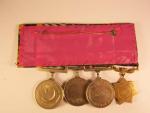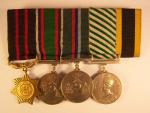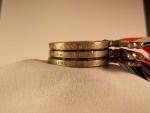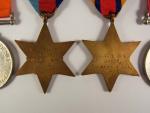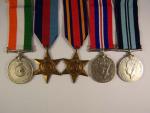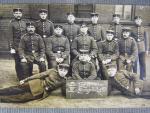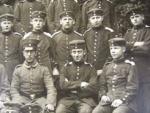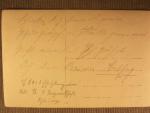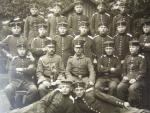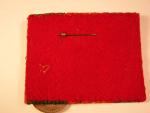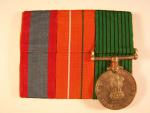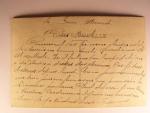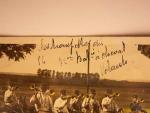-
Posts
6,486 -
Joined
-
Last visited
-
Days Won
10
Content Type
Profiles
Forums
Blogs
Gallery
Events
Store
Everything posted by Brian Wolfe
-
Here is the reverse. The plastic, as I mentioned earlier, reminds me of shower curtain material. A good example of making due with what is at hand. Something we in the West, for the most part, have forgotten how to do. Cheers Brian
-
Thanks Ed, I've just made the edit. Brian
-
Hello Everyone, Here is a group of five medals that I purchased a while ago with one medal being represented by its ribbon only. When I saw this group for sale I thought that perhaps the missing medal had, at one time, been with the group. When the group arrived it was evident that the medal had never been attached. I now know this to be fairly common. I believe this group to be original based mainly on the mounting style itself. The back of the mount has plastic similar to what might have come from a shower curtain. The group consists of: Istar-i-Herb 1391/1971 War Star Tamgha-i-Jang 1965 War Medal Tamgha-i-Jang 1971 War Medal Wiladat-i-Quaid-i-Azam Medal Hijri Medal (ribbon only) I hope you like the group. Cheers Brian
-
Here's the naming on the medals with the India Independence Medal on the top showing the Deccan Horse naming. Cheers Brian
-
-
Hello Everyone, Here is a group of medals named to a Jemadar who served in Burma with the Deccan Horse. All medals are named to: I.O. 51849 JEMDR. DILBAGH SINGH I.A.C. with the India Independence Medal showing tje DECCAN HORSE in place of I.A.C. Many thanks to Ed for his information regarding the fact that while I posted this on another forum under Pre Independence India. the presence of the India Independence Medal actually makes this a Post Independence group. He also answered my question as to the meaning of I.O. (Indian Officer). The group had black thread attached to the ribbons in such as way as to make me believe these were swing mounted at one time. It's my intention to court mount the group in time using the original ribbons as they are long enough and in very good condition. A Short History of the Deccan Horse: In 1916 the Deccan Horse made a historic charge in the French sector of the Western Front at a time when the calvary charge was pretty much considered a thing of the past. You should check out the article from the New York Times, October 15, 1916 on the internet, it's well worth your time. From www.geocities.com comes the following information. "During the Second World War, having converted to tanks, the regiment took part in the reconquest of Burma. It won 36 gallantry awards and five battle honours which included "Meiktilla and the Rengoon Road", "Capture of Meiktilla", "Defence of Meiktilla", "Pyabwe" and "Burma 1942-45"." Cheers Brian
-
To add to Hugh's information, this medal was issued 5 May, 1950 (2593 BE). Cheers Brian
-
Hello Everyone, I have purchased a pohoto postcard of a group of soldiers from the 135th German Infantry. I can't seem to find much information on the 135th except for a newspaper article dated August 30, 1914, which places them on the Western Front at that time. If someone could please translate the sign in front of the soldiers in the photo I would greatly appreciate it. The officer, or is he an NCO?, has been awarded the EKII. Thanks for any help you can give me. Here's the newspaper article. WIPED OUT A COMPANY ____________ French Bayoneted Germans Whom They Accused of Treachery. PARIS, Aug. 29. - Among the prisoners who have just died in a hospital at Troyes, Department of Aube, says the Petit Troyes, was a Lieutenant of the 135th German Infantry, whose company had sustained severe losses at the hands of the French troops and had been ordered to surrender. When the French soldiers approached to disarm the Germans the latter separated to let through their ranks machine guns which had been hidden behind, and which poured a murderous fire into the advancing Frenchmen. Exasperated by this treachery, says the paper, the French troops charged furiously with fixed bayonets and exterminated the German soldiers with the exception of this Lieutenant, who survived for a few days with his jaw fractured and his tounge cut off. The New York Times, Published: August 30, 1914 Has anyone heard of this incident or knows more about the 135th? Thanks Brian
-

Naik Mohinder Singh, I.E.M.E.
Brian Wolfe replied to Ed_Haynes's topic in Great Britain: Orders, Gallantry, Campaign Medals
Great bar Ed. Thanks for showing it. Cheers Brian -
Now the history. 84th Infantry Division (German Empire) The 84th Infantry Division (84 Infanterie-Division) was a unit of the Imperial German Army in World War I. The division was formed in November 1914 as the "Division Posen 2", part of the PosenCorps (Korps Posen), and became the 84th Infantry Division in June 1915. It was initially formed from the garrison infantry regiments of Fortress Posen (Festung Posen). The division was disbanded in 1919 during the demobilization of the German Army after World War I. Division Posen 2 initially served on the Eastern Front, fighting in Poland, including at the 1914 Battle of Lodz and then spend most of the period until mid-1915 fighting along the Rawka and Bzura Rivers. On June 2, 1915, it became the 84th Infantry Division. It fought around Warsaw in July and August 1915 and then in the pursuit of retreating Russian forces. From September 1915 to July 1916, it occupies the line along the Servech and Shchara Rivers. From July 1916 to June 1917, it occupied the line along the Berezina and Neman Rivers until the armistice on the Eastern Front. At the end of December 1917, the division was sent to the Western Front. It occupied the line by Verdun from January to May 1918 and then moved to the Somme region. It remained in the line until the end of the war. Allied intelligence rated the division as fourth class. If there is anything you can add to this history please do so. Cheers Brian
-
Hello Everyone, Once again I have purchased a photo postcard that I can not translate, though I have more infomation on the unit than usual. Any help with the translation would be greatly appreciated. After the photos I'll write the information on the 84th that I found on Wikipedia. The first thing that struck me about this photo was the age of the soldiers. They look like kids! I'm not sure if anyone can identify the time frame for this photo, it will probably be difficult, since the unit itself was active throughout the war. In particular I noticed one young fellow who is seated on the front row next to the officer (NCO?). You know this fellow would have been hell on leave (lock up your daughters). The officer or NCO next to him has the EK II ribbon while the officer with the sword has a ribbon bar with a single ribbon. It looks to have three stripes with the centre one the lightest. Any ideas as to what this would have been and what the actual ranks of the two officers would be? The belt buckles are the familiar "Gott Mit Uns" motif. Thanks in advance for any assistance you can give me. History of the 84th to follow the last photo posted (this may take a while as I am not fast with posting several images). Cheers Brian
-

Independent India - group of 3 medals with 2 missing
Brian Wolfe replied to Brian Wolfe's topic in South Asia
-
Hello Everyone, Here is a group of three medals I purchased resently with only one of the three medals actually present. The medals and/or the ribbons representing the medals are: Special Service Medal (1986) Sainya Seva Medal (1960) 9 Year Long Service Medal (1971) This group was awarded to: 14491923 GNR. K. PINGLELG. ARTY This group was posted on the SAGONGS forum and I think the following comments that were recieved sums up this group, and others like it, pretty well. "A very common pattern, where medals have not been issued. At least they weren't replaced with ugly shiney tailor's copies. ... A nice example of current phaleristic reality." - Thanks to Ed Haynes for his comments. I have seen this before and in fact one of my Pakistan groups has one medal absent. I'll post that another time. Cheers Brian
-

WW I Canadian soldier
Brian Wolfe replied to Brian Wolfe's topic in Great Britain: Militaria: Badges, Uniforms & Equipment
Hi Guys, Thanks for your kind words. I am putting together a more detailed work on his life and the battle in which he died. It will take a while as summer is a busy time for me and that makes for slow research work. Thanks again. Cheers Brian -
Hello Boris, There is no such thing as late when more information is concerned. Many thanks Brian
-
Oh man, this is worse than when I was a kid and waiting for school to close for the summer. Of course I started waiting around October. I had better order a couple because the first one will be worn out in no time. This will probably mean this winter will be spent correcting all of my mislabelled gongs. Cheers Brian
-
Hello Veteran, This is a great help, thank you very much. Cheers Brian
-
Thank you very much for the translation. Knowing what is written on the backs of these cards helps to add a human aspect to what would only be an interesting photo otherwise. Thanks again. Cheers Brian
-
I can not imagine how happy you must be to finally see this work in print. Congratulations! Cheers Brian
-
This is the message on the back. I hope someone can translate the script. Thanks again for any help you can give me. Cheers Brian
-



